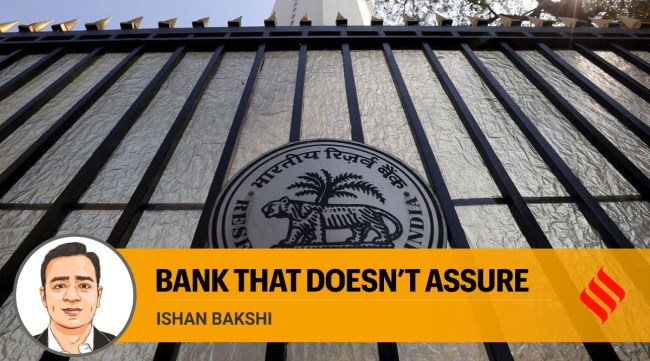Opinion RBI has been tough on inflation, optimistic about growth. This raises questions
RBI has been sounding tough on inflation while being optimistic about growth. This creates confusion and raises worrying questions over its assessment of the economy.
 The RBI has projected the economy to grow at 6.4 per cent in 2023-24. This is only 0.6 per cent lower than the 7 per cent growth expected in 2022-23. (Express Photo)
The RBI has projected the economy to grow at 6.4 per cent in 2023-24. This is only 0.6 per cent lower than the 7 per cent growth expected in 2022-23. (Express Photo)
In its last meeting, the monetary policy committee had voted to raise the benchmark repo rate by 25 basis points. The tone of the policy statement was markedly hawkish even as two members voted against the rate hike. The minutes of the meeting released last Wednesday suggest that, even as the dissent within the committee grows, the MPC is perhaps not done raising rates.
This projected hawkishness sits rather uncomfortably with the central bank’s fairly optimistic assessment of the Indian economy. The RBI has projected the economy to grow at 6.4 per cent in 2023-24. This is only 0.6 per cent lower than the 7 per cent growth expected in 2022-23 (and this difference does not even adjust for the base-effect induced bounce in the first half of 2022-23). In fact this forecast is at odds with assessments by most analysts who have pegged growth at 6 per cent or lower. It also flies in the face of slowing growth momentum across both the global and domestic economy. Unless of course the RBI believes it can engineer the softest of all landings.
This complicated balancing act that the RBI is currently engaged in — sounding tough on inflation while talking up growth — sends confusing signals. It raises questions over the ability of an inflation targeting central bank to bring inflation under control and calls into question its assessment of the Indian economy.
On the inflation front, the persistence of high core inflation is undoubtedly a cause for concern. Core inflation has now been elevated for several months. But, the only sentence in the monetary policy statement that provides some clues on the trajectory of core inflation is this — “the ongoing pass-through of input costs to output prices, especially in services, could continue to exert pressures on core inflation”. The minutes of the committee meeting add little insight. For instance, there is little elaboration on the economic context against which core inflation has remained elevated. Is it the case that companies are able to pass on higher input costs because of reduced competition or relatively healthy demand? Is the pass through process being spread out because of the inability of households to absorb the increase at one go? Are wages chasing prices chasing costs?
If market competition has indeed reduced — an outcome of high death rates across MSMEs and the informal sector — then it is conceivable that the remaining firms, especially the large ones, have greater market power which has translated into greater pricing power. In this case firms would have been able to push up prices, perhaps gradually, despite weak aggregate private demand and slackness in the labour market. While this sounds plausible it runs counter to the narrative of demand being “resilient”.
If private demand is indeed “solid”, as the government has been constantly suggesting, perhaps because the more affluent households have been drawing down on their excess savings during the pandemic and perhaps because wage income has picked up as labour markets have tightened in some segments, then, in that case, inflation is an outcome of a relatively buoyant economy. This implies that core inflation is unlikely to ease unless private demand and labour markets weaken considerably.
Which of these explanations is accepted would determine the policy stance, the extent of further tightening. So what are the views of the MPC members? Do they share the government’s upbeat prognosis or not? Unfortunately, there is little clarity. Terms like market power and labour markets find little mention in the MPC minutes.
So how high should rates go now? After the surprise uptick in inflation in January, some analysts are pencilling in another rate hike when the MPC meets next in April. But what should matter now is the inflation forecast a few quarters down the line (purely due to the base effect, inflation should fall in March, April and May).
The RBI has pegged inflation at 5.6 per cent in the fourth quarter of 2023-24. This projection is plausible. But considering past deviations between forecasts and reality, it is by no means certain. Nonetheless, at current interest rate levels, this implies a real rate of 90 basis points. The fundamental question is whether this real rate is consistent with a central bank adopting a tightening stance to bring inflation down to the target in the current economic environment? Or are higher rates called for? Though not exactly comparable, the real rate in the US is likely to be 2 per cent in 2023, falling to 1.6 per cent in 2024 as per the projections of the Federal Open Market Committee.
On growth too there is considerable uncertainty. In its December policy, the RBI had pegged GDP growth at 7.1 per cent in the first quarter of 2023-24 and 5.9 per cent in the second quarter. But in its February policy, it upped its growth forecast to 7.8 per cent in the first quarter, 6.2 per cent in the second quarter. So what changed in a matter of a few months?
The central bank now sees growth slowing down only marginally to 5.9 per cent in the second half of the year. There is some expectation of demand coming under pressure as the full pass through of rates materialises. But, there is little clarity on how much the fall in exports (due to tighter global monetary policy) and domestic demand (due to tighter domestic monetary policy) will separately impact growth. Its commentary continues to emphasise the robustness of both sides of the growth equation — “strong” credit growth and “buoyancy” in domestic demand.
This raises the question — if RBI intends to break the “persistence” in core inflation, shouldn’t demand side pressures on inflation weaken considerably? And wouldn’t this inflict pain in the labour market? Bringing down inflation to the target will perhaps require far greater growth sacrifice than the central bank is either willing to acknowledge or undertake. In the formulation of policy, far greater realism is called for.





